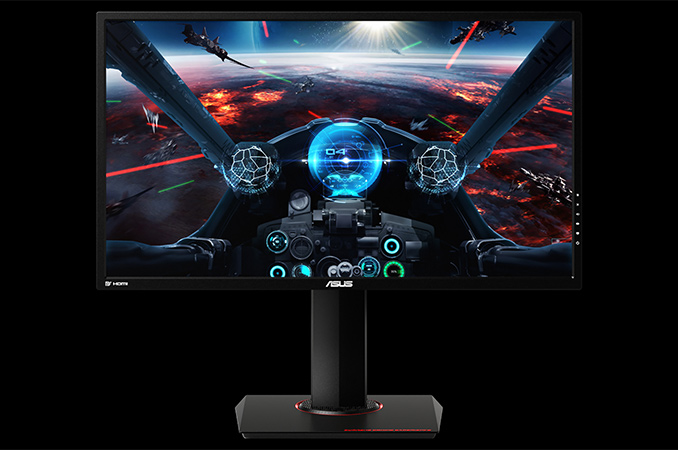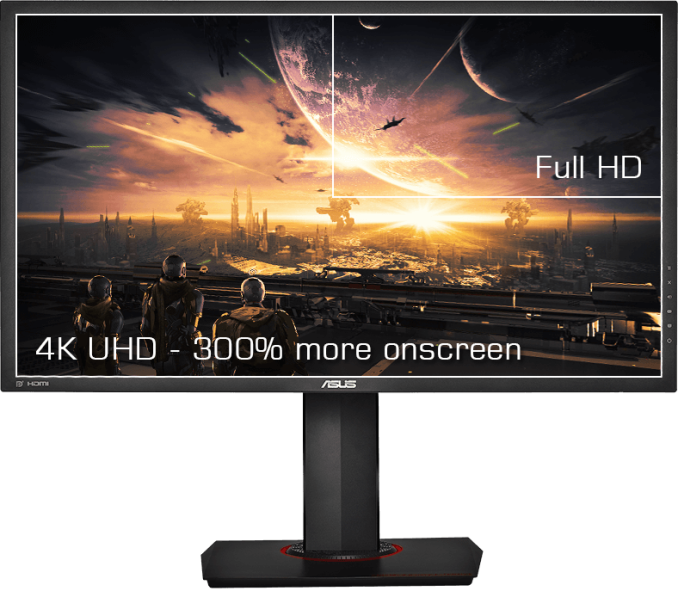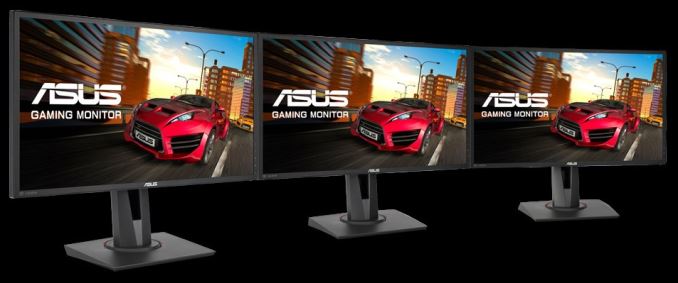ASUS Announces Three New Displays with Adaptive-Sync Technology
by Anton Shilov on April 15, 2016 9:00 AM EST
ASUS has introduced three new inexpensive displays for gamers with full-HD and 4K resolution: the MG248Q, the MG28UQ and the MG24UQ. The new monitors support VESA’s Adaptive-Sync technology and thus should be compatible with video cards that feature AMD’s FreeSync dynamic refresh rate technology. While the monitors do not carry the FreeSync badge just now, they will likely gain it eventually.
| Specifications of ASUS MG-Series Displays | |||||
| MG248Q | MG24UQ | MG28UQ | |||
| Panel | 24" TN | 23.6 IPS | 28" TN | ||
| Resolution | 1920 x 1080 | 3840 x 2160 | |||
| Refresh Rate | 40 Hz - 144 Hz | 30 Hz - 60 Hz | |||
| Adaptive-Sync Range |
unknown | 40 Hz - 60 Hz | |||
| Response Time | 1 ms gray-to-gray | 4 ms gray-to-gray | 1 ms gray-to-gray | ||
| Brightness | 350 cd/m² | 300 cd/m² | 330 cd/m² | ||
| Contrast | True contrast ratio unknown | ||||
| Viewing Angles | 170°/160° horizontal/vertical | 178°/178° horizontal/vertical | 170°/160° horizontal/vertical | ||
| PPI | 92 ppi | 186 ppi | 157 ppi | ||
| Pixel Pitch | 0.276 mm | 0.136 mm | 0.16 mm | ||
| Colors | 16.7 million | 1.07 billion | |||
| Color Saturation | Unknown | ||||
| Inputs | DisplayPort 1.2 HDMI 1.4 DVI-D |
DisplayPort 1.2 HDMI 2.0 HDMI 1.4 x 2 |
|||
| Audio | 2 x 2 W | ||||
The biggest display among the novelties is the ASUS MG28UQ, which is based on a TN panel with 3840×2160 resolution, and a 330 nit max brightness. The MG28UQ has default refresh rate of 60 Hz and supports dynamic refresh rates between 40 and 60 Hz, which is typical for 4K monitors. The display is equipped with one DisplayPort 1.2 and three HDMI inputs, a dual-port USB 3.0 hub with quick charge support as well as two 2 W speakers. The unit also features tilt, swivel, pivot and height adjustment and is compatible with VESA display wall mounts.
The ASUS MG28UQ is available now for $549 from Amazon. The product does not seem to be very affordable for a TN-based display, possibly because ASUS charges premium for the Adaptive-Sync feature. Nonetheless, the monitor is not too expensive either.
Next up, the MG24UQ is not as big as its large brother (it has 23.6” diagonal), but it will be a more interesting option for those, who prefer IPS panels with high pixel density. The monitor sports 3840×2160 resolution with up to 60 Hz refresh rate and a peak brightness of 300 nits. Adaptive-Sync works for refresh rates between 40 and 60 Hz, just like in case of the MG28UQ. The monitor features one DisplayPort 1.2, three HDMI inputs as well as two 2 W speakers. The design of the MG24UQ display is very similar to that of the MG28UQ (hence, it sports the same set of adjustments and VESA mounts) with the exception of dimensions and the lack of a USB hub on the smaller one.
The ASUS MG24UQ can be pre-ordered now for $399 on Amazon.
Finally, the ASUS MG248UQ is designed for gamers who value high dynamic refresh rates most of all other features. This display will be the first 24” monitor from the company which supports up to 144 Hz refresh rate as well as Active-Sync technology. The monitor uses a TN panel with 1920×1080 resolution and a peak brightness of 350 nits, offering slightly better specifications and a more aggressive visual design compared to the VG247H and the VG248QE. The display supports dynamic refresh rates between 40 and 144 Hz, according to ASUS, which is a very decent range. As an added bonus, thanks to the extremely high refresh rate, the MG248UQ could be used with NVIDIA's 3D Vision stereo-3D kit
ASUS plans to start selling the MG248UQ in the coming weeks for an undisclosed price. Typically, such monitors are not expensive, thus, the MG248UQ could be used to build relatively affordable ultra-fast multi-monitor setups with Adaptive-Sync.
ASUS is one of the leading suppliers of displays for gamers with a huge market share, according to the company. The new MG-series monitors should help ASUS to better address the segment of affordable displays for gamers.
Source: ASUS


















42 Comments
View All Comments
vanilla_gorilla - Friday, April 15, 2016 - link
Why would you want a 4K 42" monitor? The pixel density would be awful (~104ppi). Unless you plan on sitting 10+ feet from it?Impulses - Friday, April 15, 2016 - link
lol What? 10 feet is a gross exaggeration...It's not any more awful than the 1080/1200 24" & 1440 27" screens many are already used to, which also means zero scaling issues in Windows or games. I actually find it pretty appealing, spent a while looking at that Phillips 40" last year...
It'd be roughly equivalent to my 3x 24" when they're in portrait mode, but without bezzels in between. I find that a lot more enticing that phone-like ppi on a screen that is a couple feet from me, and going down to a single 24/27" is just my gonna happen for me work-wise.
schizoide - Friday, April 15, 2016 - link
4k at 42" is roughly the same pixel density as standard non-"retina" monitors. It's like four 20" 1080p monitors in a 2x2 configuration with no bezels-- pretty sweet.javishd - Monday, April 18, 2016 - link
Thanks guys, exactly. 100-110ppi means no scaling, which also means normal face to monitor distance 16"-30". Also, if desirable, scoot the monitor back to about 38" from face and set scaling to 150% for high dpi.In my opinion hi dpi is nice when you have size constraints, like on a laptop, so you can get that crisp text and images. However, in an office, I would always trade density for unscaled real estate.
I currently use a Wasabi Mango 43", it sits 28 inches from my face and has a PPI of about 103. Like schizoide says it's the same as bezel-less 2x2 of 21" 1080p screens. Everything about it is amazing. I have full unscaled 4k real estate, or I have 1440p effective high dpi when I scoot it all the way back on my desk. However, I think it's unlikely it will last me very long and I'm sure I can't collect on warranty.
Now if I could have the same screen size at hi dpi I would do it, but that would be a 7k-8k screen... Someday I'm sure!
ToTTenTranz - Friday, April 15, 2016 - link
If the maximum refresh rate is 60Hz for the 28" model, why not use an IPS panel?It's like Asus is dead set on inducing caveats in every single monitor in their line-up.
willis936 - Friday, April 15, 2016 - link
Remember the price point. You could get all of the boxes ticked (within reason, no wide gamut or high refresh rate 4K yet) monitors months ago but as soon as you pick a price you have to shave features.JoeyJoJo123 - Friday, April 15, 2016 - link
There are no 28" 4k IPS panels in production, AFAIK.27" 4K IPS, yes, but not 28".
Henry Tobias - Saturday, April 16, 2016 - link
I'm writing this comment on an ASUS X501 laptop. The first and last ASUS product I will buy. It did not even last the 3 year guarantee period without problems.Rishi100 - Saturday, April 16, 2016 - link
I think reviewers or the news item writer must also indicate:1. Whether display supports HDR with rec 2020 games spec?
2. HD I.2 supports HDCP 2.2 or not?
Please ask these answers from manufacturer when u review these babies.
Rishi100 - Saturday, April 16, 2016 - link
Not games but gamut.